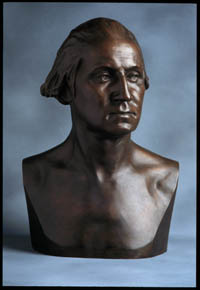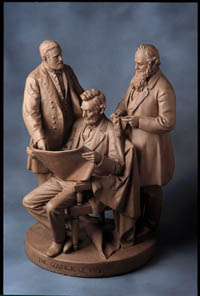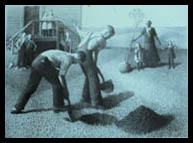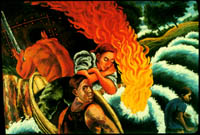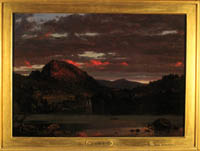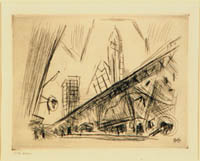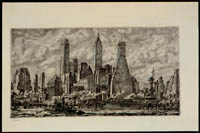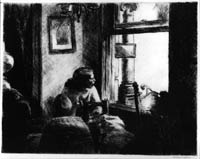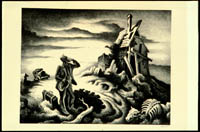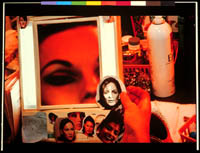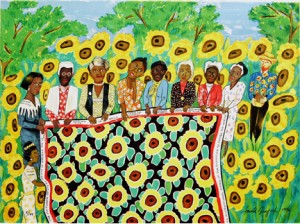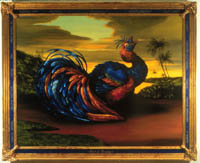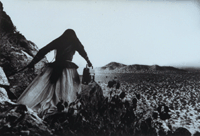American Art & National Identity
Introduction
The exhibition American Art and National Identity is the second in a series of exhibitions interpreting the permanent collection of the Brauer Museum of Art at Valparaiso University. It is part of a larger project entitled “Nature and Culture in American Art” which was made possible through a matching grant from the Indiana Humanities Council in cooperation with the National Endowment for the Humanities. Additional support was provided by the Brauer Endowment and Valparaiso University. This series was designed for teachers and students of all ages to use the museum’s collection as a “visual library” to study the humanities through art. Each exhibition in the series was first realized as a pilot on-line exhibition which was discussed by a focus group of teachers in the humanities. To revisit the exhibition, visit the Brauer Museum’s website at: www.valpo.edu/artmuseum.
The exhibition was curated and the following essay written by Dr. David Morgan, former art department chair and noted scholar who has published widely in the field of 19th- and 20th-century American art. We very much appreciate his contributions to this project. We especially want to thank John Paul Avila (Class of 2000) for the design of the website, and Kirsten Renahan of our Museum Education Committee for her contributions to the teacher packet. Particular mention must be made of the work of Juliet Istrabadi for her coordination and editing of the on-line project. We also thank Jason Bense (class of 2001), Wendy Barker (Christ College Class of 2000), Rebecca Simons, Cristina Grevera, and Gerald Knarr for the installation of the exhibition.
Rita E. McCarthy
Former Director/Chief Curator,
Brauer Museum of Art
Gallery Guide Questions
Prepared by Rita McCarthy, former Brauer Museum of Art Director, and David Morgan, former Art Department Chair and Curator of the Exhibition.
- Grant Wood’s lithograph entitled Tree Planting Group may represent Arbor Day in the heartland of the American Midwest (Iowa, the home state of the artist). What attitude toward nature does this ceremony enact? Compare this image with Bearden’s In the Garden. Is there a difference in the figure’s relationship to the landscape in each image? Are there different allusions or iconographical sources for each image?
- Faith Ringgold’s lithograph, The Sunflower Quilting Bee at Arles, borrows a motif from the art of Vincent Van Gogh. Quilting as an art form with colorful abstract shapes and forms had a long tradition among women (black and white) in America. It is a craft that preceded Modernist art. Why has Ringgold included Van Gogh into this composition designed to celebrate important African-American women? Is the size of the figure significant in this composition? Why would quilting be considered an appropriate metaphor for politically progressive black women?
- Bearden’s In the Garden portrays a beautifully-dressed African-American woman in a garden. Is she a heroic figure? If so, why? How does Bearden use the symbol of the dove in this image? Is there a literary reference in this image? What other women in the Bible are portrayed in gardens?
- Compare Laurie Hogin’s landscape entitled Imperial Eyes: Indonesia with the painting adjacent to it by Frederic Church. How do the two artists view nature? How has Hogin’s environment transformed this Bird of Paradise? Is this “Paradise Lost”? How does the text on her frame serve to shape the overall meaning of her painting? How does the relief of bats on her frame reinforce her message?
- Compare Paul Sierra’s emigration from Cuba (Family Portrait) to a work with a similar theme in the Bearden exhibition, Train Whistle Blues. How do Sierra’s heavy use of paint and jarring colors compare with the medium of black and white collage? How do the formal elements in each serve to disquiet the viewer? Sierra and other artists in both exhibitions rely on religious and mythological allusions in their works. Can you identify any of these?
- Compare the imaging of women in Lauren Greenfield’s I Approve of Myself with Bearden’s imaging of African-American women in the collage entitled Mysteries. Greenfield and Bearden each draw on many sources of the self available to them in mass culture. What is the self under construction in Greenfield’s photography and how does it compare with the self under construction in Bearden’s work? Is it meaningful to speak of Greenfield’s “I” in question as personal and Bearden’s as the collective self of all African Americans? Identify the sources of the self in both Bearden and Greenfield? Where does Bearden collect his imagery? Where does Greenfield gather hers?
- American civil religion consists of rituals, ceremonies, narratives, heroes and heroines, songs, music, images, statuary, and such sacred spaces as battlefields and the Mall in Washington, D.C. The intention behind the practice of civil religion is to preserve the constitutional importance of separation of church and state while creating in broadly religious terms the means for Americans to experience a single, collective sense of national identity. Each of the artifacts, places, and occasions mentioned above are what Americans are meant to share in a very public way despite their many differences. The bust of George Washington and the statue of Abraham Lincoln (Council of War) are two significant examples of American civil religion. Why? Do they actually work to unite Americans?
- The identity of the United States is something that is constantly under revision. In fact, this nation has never been a simple, monolithic entity. The sculpture by George Lopez and the photograph by Graciela Iturbide remind us of the important history of Latino and indigenous cultures in the composition of America. How does Iturbide’s photography subtly display the intermingling of cultures? And how does Lopez’s sculpture mark the interaction of indigenous and European art and religion?
- In the nineteenth century most Americans lived in the countryside. But the end of the century marked an important shift toward the city. Many immigrants settled in cities and great wealth was concentrated in banks, factories, and businesses in important commercial centers like New York and Chicago. The city emerged in the twentieth century as the symbol of American identity. Can you discern in the prints by Marin and Marsh how the city was regarded? And is there an alternative view in the etching by Hopper?
Essay by David Morgan, Ph.D.
Fig.1 Wilson MacDonald
(after Jean Antoine Houdon)
Bust of George Washington, 1898, bronze,
18-3/8 x 12-9/16 x 8-7/8 inches
Brauer Museum of Art, Gift of the Class of 1898
Since the early days of the British colonies, Anglo-Americans have been fond of claiming for themselves a sense of uniqueness, often expressed as a national mission or vocation. Although scholars of American history and culture over the past twenty years have criticized “American exceptionalism” as promoting national self-interest, the idea is still powerful among many Americans today. This is not really surprising since any nation will tend to seek out its own interests. Just as families, towns, and regions exhibit common features, a nation will install a particular character in the cultural representations it produces and uses as a way of establishing its identity for its members as well as for other nations. But determining what that character is, who has it, who does not, whether or not it is the only or official character, and what it all means is a thorny issue. Throughout their history, Americans have actually been a variety of many peoples joined by geographical and historical circumstances. Such shared experiences as war, national tragedy, political ideals, sports, religion, public education, popular entertainment, and the English language have provided a common albeit uneven and inconsistent culture.
The history of American art provides a rich record of the attempt among American artists and viewers to visualize American identity. In prints, paintings, sculptures, photographs, and drawings we can find diverse paths in the quest for national character. What are the memories and stories Americans treasure? What are the national rituals and ceremonies they preserve? What places capture the national imagination and what events occupy artists (and their publics) when they think about who Americans are? These are some of the questions that will guide our consideration of several works of art in the Brauer Museum of Art.
One of the oldest, most traditional ways in which Americans have told themselves who they are is by erecting monuments to their heroes as a way of publicly remembering what they did and how the present is rooted in the achievements of the past. The head of George Washington is certainly the most widely recognized “American” image in our culture. From the earliest days of the American republic, first General, and then President Washington was the “father” of the American nation.[1] It was his military leadership and republican wisdom that helped birth the nation and guide it through its first, perilous moments. In 1785, the French sculptor Jean Antoine Houdon came to Mt. Vernon, Virginia, to create a bust of Washington by taking a mold from life. Houdon then cast a clay model, which he retouched according the neoclassical fashion of his day. Washington looks more like an ancient Roman senator or Greek hero than he does an eighteenth-century landowner (fig. 1). But the solemn expression, smooth complexion, square features, and prominent forehead were conformed to the classical ideal of nobility. Washington’s actual appearance was translated into the visual language of heroism.
Fig 2. John Rogers, 1829-1904
The Council of War, 1868, Cast plater, 24-1/4 x 16-3/4 inches
Brauer Museum of Art, 75.16
Houdon’s sculpture became the prototype for thousands of public monuments placed in parks, museums, libraries, and schools. It even ended up on the quarter. The bronze bust in the Brauer Museum carries on its verso a “certificate and oath” from the New York bronze founder who cast it in 1898, indicating that the work is a “perfect reproduction of the Life-Cast” by Houdon. This assurance of authenticity mattered to patriotic Americans because they wanted “the real thing,” an icon of their country’s father. This image, like no other, has been the official symbol of American identity for generations because it symbolizes the ideal of heroic self-denial that many Americans have historically wished to serve as the origin of the nation. Washington avoids any expression of emotion because he represents a fusion of individual and type into the single figure of the archetypal national hero. He does not call attention to himself, but to the nobility of virtuous deeds, those that create the national character that John F. Kennedy had in mind when he urged Americans not to ask what the country could do for them, but what they could do for their country.
Even if many Americans today are unmoved by the call for republican selflessness symbolized by the neoclassical severity of Houdon’s portrait, Washington remains the most familiar president in part because his image has presided over so many of the national rituals and ceremonies in which Americans have participated. The Fourth of July, Veterans Day, Memorial Day, Presidents Day, and any pilgrimage to the Mall in Washington, DC, is incomplete without the face of Washington. His portrait was used in the early editions of Noah Webster’s American Speller and by a host of American primers, the basic school books for generations of American youth from the late eighteenth century throughout the nineteenth century. This very public portrait, joined by others such as Abraham Lincoln’s (see John Rogers sculpture group, fig. 2), quickly became the core of an American civil religion, a set of images, rites, places, and documents (such as the Declaration of Independence and the Constitution) that all Americans were thought to hold in common. In fact, of course, African Americans and Native Americans did not enjoy equality in this national cult. It took the national travail of the Civil War to begin the march toward freedom, a development consecrated by the carnage of the war and commemorated by Rogers’ ceramic sculptural group of President Lincoln, General Grant, and Secretary of War Stanton holding a council of war (fig. 2). Violence and suffering often establish the sacred spaces and saints of civil religion such as battle grounds or heroes like Lincoln and Martin Luther King. The power of civil religion is its broad public recognition and its centrality in government and government-sponsored activities such as public school (think of the Pledge of Allegiance), national holidays, and the court room (where Washington’s, Lincoln’s, or King’s portraits are likely to hang). Civil religion is a public and formal construction of memory through an apparatus of rituals that rely on images, music, and other art forms to organize national consciousness. Many of the basic elements of organized religion such as rituals of sacrifice, redemption, and commemoration inform civil religion, which has been very important in American life where a careful separation of church and state has avoided the establishment of any religion as the official faith of the nation. Civil religion has bridged the different religions and made a single public space in which Americans join one another for a spiritual observation of their national identity. [2]
Fig. 3, Grant Wood, 1892-1942
Tree Planting Group, 1937,
Lithograph, 8-1/4 x 10-3/4 inches
Brauer Museum of Art, Sloan Fund Purchase, 74.4
Iowan artist Grant Wood produced a charming lithograph of just such a national ritual, possibly Arbor Day, in which a public school teacher and her students celebrate a public event of planting a tree as a symbol of national perpetuity and rich national resources (fig. 3). Wood was a Regionalist artist, someone who believed that American culture could produce a characteristic artistic vision that did not require the emulation of European art. Regionalism sought out subjects and styles of image making that would deepen Americans’ awareness of their own national culture. Oftentimes, Wood did so with tongue-in-cheek, with a robust consciousness of the narrow mindedness and provinciality of many Americans.
But he also painted the native wealth of what he saw such as the rolling prairie and neatly manicured towns of Iowa. He portrayed the rural world of the Midwest with the caricaturist’s eye for the type, whether person, period, or place. Characteristic of Wood’s art, Tree Planting Group (fig. 3) uses a naïve style drawn from folk tradition and decorative art in order to suggest something that is true in the manner of a popular tale or folk memory. The naïve style and the selection of nostalgic subjects recalls such popular visual culture as Currier & Ives prints and the contemporary sentimentality of Norman Rockwell, but interposes between the artist and his subject-matter a wry distance that makes his pictures a subtly ironic act of reflection on the prospect of painting the American character.[3]
Fig 4. Paul Sierra, b.1944
Family Portrait, 1991,
Oil of canvas, 60 x 90 inches
Brauer Museum of Art, Sloan Fund Purchase, 92.8
If Anglo-Saxon Americans wanted to believe that their nation was as self-generating as the act of planting trees, the reality was that the nation was the result of immigration and colonization, a dense intermixture of racial and ethnic groups over many generations. In the nineteenth century Irish, German, Slavic, Italian, and Asian immigrants joined the Anglo, African, and Latino immigrants of former generations. Immigration has continued to this day to enrich the nation with renewed stories of exodus and deliverance. Paul Sierra’s Family Portrait (1991; fig. 4) conveys the mythic stature of emigration in the mind of a young boy who crosses the stretch of water separating Cuba from the United States. A column of fire, a watery passage, the loss of one world and the discovery of a new one these are the elements of mythic narrative, of an epic quest for the self and homeland.
Fig 5. Frederic Edwin Church, 1826-1900
Mountain Landscape, ca. 1849,
Oil of canvas, 14-1/2 x 19-3/4 inches
Brauer Museum of Art, Percy H. Sloan Trust, 53.1.107
With the rise of American wealth and industrial productivity, fueled by the labor of immigrant workers and a vast landscape rich in natural resources, a new symbol of American identity emerged in the twentieth century: the city. The American frontier had been for generations a providential affirmation of American national destiny, and had been captured in the sublime style of landscape painting by Frederic Church and Albert Bierstadt. In the Brauer’s Mountain Landscape by Church (ca. 1849; fig. 5), for example, the incandescent clouds and the glowing face of the mountain suggest an act of revelation as the day passes into night, or as the dawn first arrives.
Fig 6. John Marin, 1870-1953
Downtown, the El, 1921,
Etching, 6-7/8 x 8-7/8 inches
Brauer Museum of Art, Gift of the FRIENDS of Art, 94.15
By the turn of the century, however, the American city became a potent symbol of national power. If the wilderness landscape had served as the symbol of divine promise, the city was proof of Yankee productivity, America come of age, a dynamo of industrial achievement. John Marin’s dynamic print of New York’s elevated train (fig. 6) communicates the excitement that many Americans felt about the urban landscape with its towering heights and endless bustle, its hymns to technology and industry and the power of capitalism to transform the landscape into a modern metropolis.
Fig 7. Reginald Marsh, 1898- 1954
Skyline from Pier 10, Brooklyn,
Etching 6-3/8 x 11-15/16 inches
Brauer Museum of Art, Gift from Ester Sparks, 98.6
If the garden paradise had been the emblem of American ideals in the nineteenth century, the city captured many hopes in the twentieth as the promise of convenience, leisure, and opportunity. Reginald Marsh’s Skyline from Pier 10, Brooklyn (fig. 7), applies the visual formula of the sublime mountain scape of earlier painting to the energetic, irrepressible skyline of Manhattan. The work of humankind was replacing the handiwork of God. The crenelated building in the foreground and the looming skyscrapers suggest the proud edifices of a modern Babel. This is a powerful example of American optimism and pride, of boundless hope in what national industry and a robust economy can do. Anchored confidently in the foreground is a naval destroyer, symbol of American might. [4]
Fig 8. Edward Hopper, 1882-1967
Eastside Interior, 1922,
Etching, 7-3/16 x 9 7/8
Brauer Museum of Art, Sloan Fund Purchase, 74.2
But there were limits to this optimism and a dark side to modern urban life. Edward Hopper’s haunting print of Eastside Interior (fig. 8) glimpses the psychological and social alienation that is the underbelly of capitalist production. People, women and minorities in particular, are frequently isolated as the powerless and the victimized, as the cogs of an immense economic apparatus that tends to reduce human beings to the exchange value of their labor. Hopper’s subject peers desperately out of a window as she works at a sewing machine. Her knobby hand tends the device as she looks without hope at a world of which she is deprived just as we viewers are not allowed to behold what she sees.
Fig 9. Thomas Hart Benton, 1889-1975
The Prodigal Son, 1936,
Lithograph
Brauer Museum of Art
Alienation also looms in Thomas Hart Benton’s retelling of the parable of a prodigal son, who has returned to the broken-down hovel of his childhood home (fig. 9). Victim of the dustbowl and the economic depression of the 1930s, Benton’s prodigal may have left the failing homestead to find his fortune. He returns to his place of origin in search of something irreplaceable, but finds it destroyed. The wayward son is deprived of home, the place where the prodigal would secure the affirmation of his progress in the world, and is instead greeted by the sun-scorched skeleton of the fatted calf and the broken remains of his father’s house.
Fig 10. Lauren Greenfield, b.
I Approve of Myself, 1995,
Cibachrome, 1/25
Brauer Museum of Art, Gift of the FRIEND OF Art
1999.3
If Benton’s prodigal laments the stark loss of the self and Hopper’s lonely figure suggests that there is no possibility of reversing this loss, Lauren Greenfield may hold out hope as she focuses on the mass-culture sources of the modern self and how they are used to construct personal identity in the ordinary lives of working people. Greenfield’s Cibachrome print (fig. 10), tinted in the warm, orange hues of women’s magazines, documents a woman’s daily manufacture of herself in a series entitled “Show Girls.” Fascinated by the irony of the impersonal mechanics of personal identity construction, Greenfield explores how identity is donned for display.
Assembled from fashion photos and applied with cosmetic brush, hair spray, and eye liner, feminine beauty cloaks the self beneath a mantle of hyper-feminine spectacle. “I approve of myself,” a therapeutic note of self-encouragement, adheres to the vanity mirror, but problematizes the “I” by pairing it with the looming, blurred reflection of the subject’s eye. The hand of the photograph’s subject holds a cut-out face that looks at the viewer through the mask of fashion. Importantly, this small image is overlaid by yet another image. At the center of the photograph resides an ambiguity that no self-approval can resolve. And yet one wants it to be resolved. This woman’s fate is our own, for each of us looks to the mass-produced world around us for cues to the identities we assemble and perform on the social stages of work and play. In the flurry of commercially-generated identities, there is the longing for an “I” to be accepted and affirmed.
Fig. 11 Faith Ringgold, b.
The Sunflower Quilting Bee at Arles,
Lithograph
Brauer Museum of Art, Collings Fund Purchase, 96.7
Where Greenfield wonders and hopes, Faith Ringgold proclaims and celebrates. Ringgold is convinced that the visual world of art is available as an iconographical resource for recovering and honoring female identity in the national context of American Black women. Her large lithograph, “The Sunflower Quilting Bee at Arles” (fig. 11), gathers several heroic Black women of the American past around a quilt of sunflowers as an emblematic statement of unity. The quilting bee is a traditional activity of American women, a practice in which women dominate and metaphorically create the fabric of domestic life as well as a social space in which women are in control and enjoy friendships with one another. Moreover, reminiscent of commemorative prints displaying the portraits of African-American clergy, Ringgold’s image configures the visual unity of these women into a kind of historical community, a quilted, intertwined tradition of persons dedicated to changing the world, as an inscription on the quilt they’ve collectively produced puts it
The print borrows a famous motif of sunflowers by artist Vincent Van Gogh and redeploys it as a metaphor of feminine strength and intergenerational commitment. Art and art-making are symbols of unity and a creative, constructive tradition of solidarity and female self-assertion. Van Gogh, the single man in the picture, appears respectfully at the side, holding a pot of sunflowers. His is an honorific presence, a decorative detail that diminishes before the grander display of the quilt and its proud makers. Where Van Gogh failed to create a Utopian community of artists in the south of France, at Arles, Ringgold proclaims an intergenerational victory of women gathered about the symbol of their collective work.
Fig. 12. Lauri Hogin, b. 1963
Imperial Eyes: Indonesia, 1997,
Oil of canvas,
Brauer Museum of Art, Sloan Fund Purchase, 98.1
Identity is a fragile thing, as the work of Greenfield and even Ringgold suggests: it is the product of struggle and deliberate assertion, and it is always in need of maintenance. But identity is also the result of social forces much larger than the personal self. It depends on a degree of material wealth and control over the natural world to anchor identity to an enduring place. But Laurie Hogin’s painting, Imperial Eyes: Indonesia (1997; fig. 12), indicts western capitalism for a maniacal reduction of the world to commodity, transforming everything into the logic of the global marketplace. America is neither garden of paradise nor triumphant urban dynamo, but the unseen hand of exploitation. Indonesia’s exotic Bird of Paradise croaks under the assault of capitalism. The lush image of the bird contrasts with the tags of American consumerism that are inscribed in the frame: coffee, tea, palm oil, feathers, tobacco, tropical hardwoods, rubber. These are what Indonesia really means to American well-being, Hogin announces. America is a voracious appetite.
Fig. 13. Graciela Iturbide, b. 1942
Mujer / Angel (Angel Woman), 1996,
Photogravuer, 25/30,
17 1/8 x 24 9/16 inches
Brauer Museum of Art,
Gift of T. Marshall Rousseau, 96.26.2
In spite of America’s bullish way with the world, people persist. They refuse to be diminished to grist for the economic mill. Graciela Iturbide’s marvelous photograph, Angel/Woman (1979; fig. 13), shows a Mexican woman in the Sonoran Desert fabricating her existence from a cultural past, a bleak landscape, and the consumerist world of American capitalism represented by the ghetto blaster she totes through a difficult passage.[5] Identity is not something one inherits intact and is destined to carry through life as a fixed burden. Character is the product of history, a hybrid of cultures, and the choices that individual people make about the lives they wish to lead. Identity is negotiated between the present and the past. This woman, a Seri Indian whose face is hidden from view, walks in her traditional dress as if out of the magical space of a novel by Gabriel Garcia Marquez. She is an anomaly, but also a survivor, and more: she is a harbinger of a larger, future American identity. This mysterious Angel and Woman bears a message of what may come to pass as the border culture between Mexico and the United States broadens across North and Central America in a historical rhythm of change that we can now only begin to intuit.
Written by David Morgan, formerly Phyllis and Richard Duesenberg Chair in Christianity and the Arts, Valparaiso University, and funded in part by the Indiana Humanities Council.
A Virtual Exhibition sponsored by the Valparaiso University Brauer Museum of Art
